Bowral Topography Report: Stratification & Aquifer Impact Analysis
VerifiedAdded on 2023/06/15
|9
|1619
|441
Report
AI Summary
This report provides an analysis of the topography of Bowral, Australia, focusing on its geological layers and the impact of stratification on underground water sources. It begins with an introduction to Bowral's location and background, followed by a literary review of relevant studies on topography, underground water, and stratification in Australia. The report then delves into the geological layers found in the Bowral area, including the Finniss River Group, Katherine River Group (with its Phillips Creek Member, Edith River Volcanic, and Mcaddens Volcanic Creek Member), and the Kambolgie Formation, detailing their composition and formation processes. Furthermore, the report discusses the concept of stratification, its impact on aquifers, and the potential for contamination from radioactive wastes and other non-biodegradable substances. The report concludes by highlighting the negative impacts of stratification on human beings and overall living beings, emphasizing the importance of responsible waste disposal to protect groundwater quality. This assignment is available on Desklib, a platform offering a range of study tools and resources for students.

Running head: TOPOGRAPHY OF BOWRAL
TOPOGRAPHY OF BOWRAL
Name of the Student:
Name of the University:
Authors Note:
TOPOGRAPHY OF BOWRAL
Name of the Student:
Name of the University:
Authors Note:
Paraphrase This Document
Need a fresh take? Get an instant paraphrase of this document with our AI Paraphraser
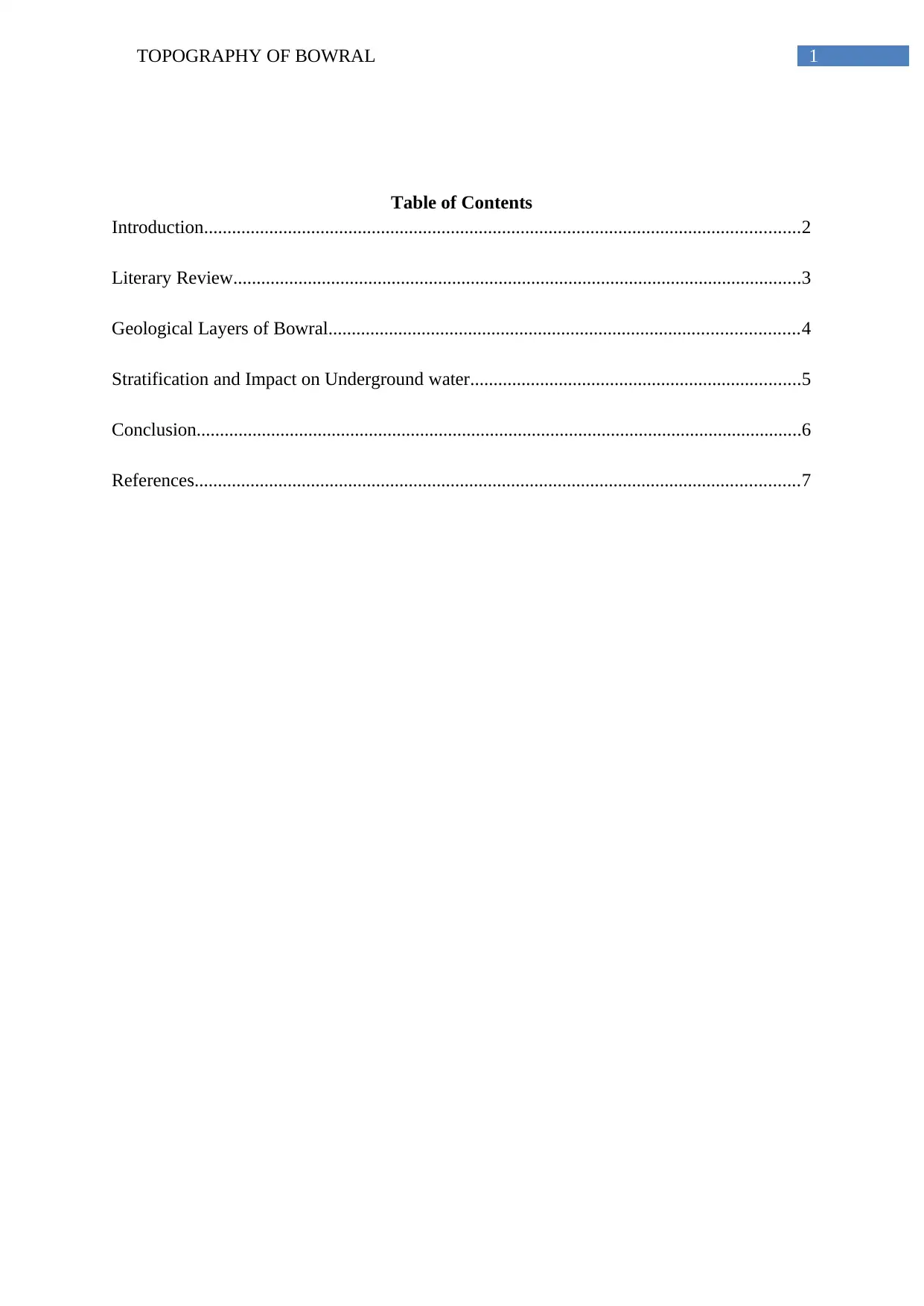
1TOPOGRAPHY OF BOWRAL
Table of Contents
Introduction................................................................................................................................2
Literary Review..........................................................................................................................3
Geological Layers of Bowral.....................................................................................................4
Stratification and Impact on Underground water.......................................................................5
Conclusion..................................................................................................................................6
References..................................................................................................................................7
Table of Contents
Introduction................................................................................................................................2
Literary Review..........................................................................................................................3
Geological Layers of Bowral.....................................................................................................4
Stratification and Impact on Underground water.......................................................................5
Conclusion..................................................................................................................................6
References..................................................................................................................................7
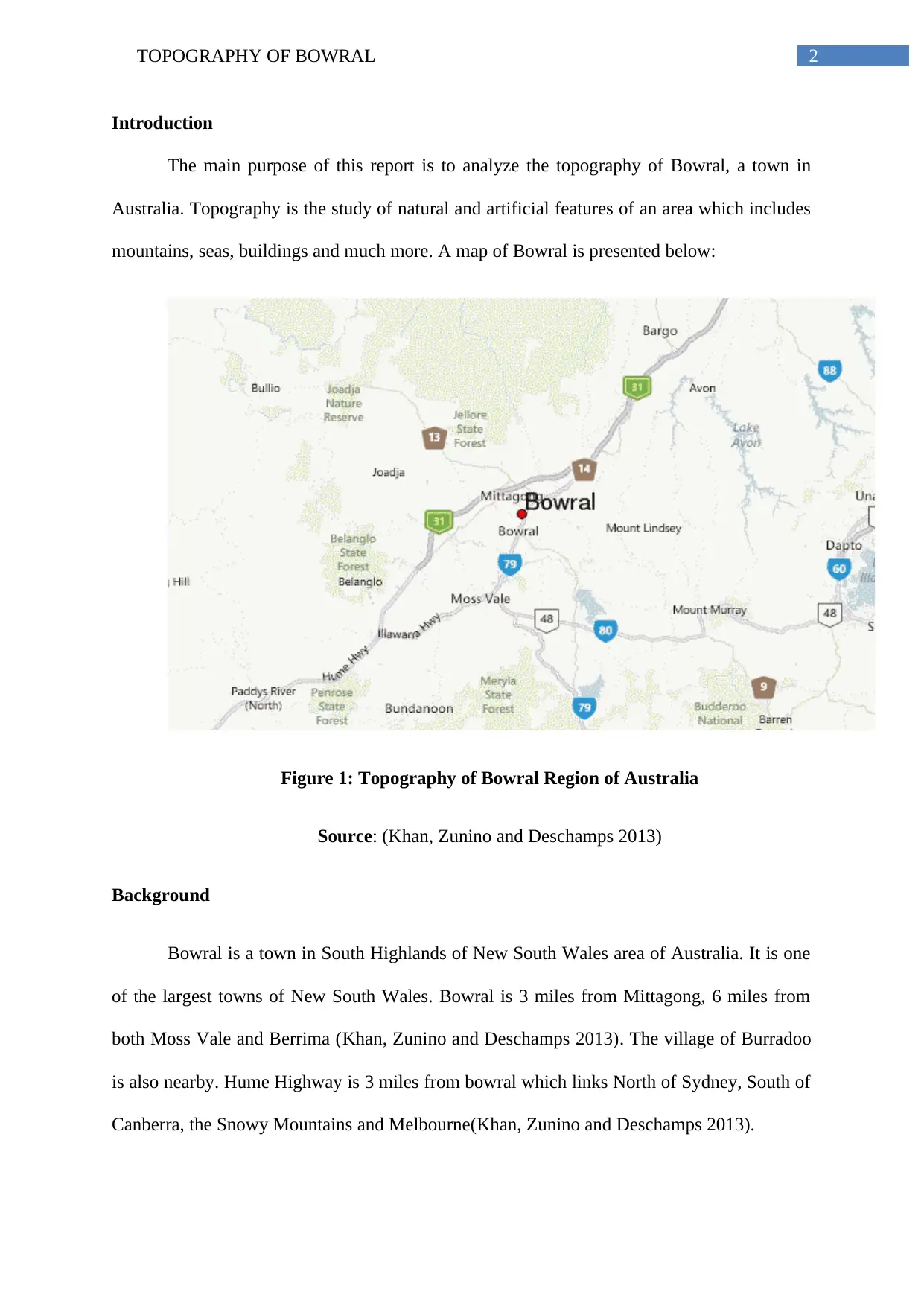
2TOPOGRAPHY OF BOWRAL
Introduction
The main purpose of this report is to analyze the topography of Bowral, a town in
Australia. Topography is the study of natural and artificial features of an area which includes
mountains, seas, buildings and much more. A map of Bowral is presented below:
Figure 1: Topography of Bowral Region of Australia
Source: (Khan, Zunino and Deschamps 2013)
Background
Bowral is a town in South Highlands of New South Wales area of Australia. It is one
of the largest towns of New South Wales. Bowral is 3 miles from Mittagong, 6 miles from
both Moss Vale and Berrima (Khan, Zunino and Deschamps 2013). The village of Burradoo
is also nearby. Hume Highway is 3 miles from bowral which links North of Sydney, South of
Canberra, the Snowy Mountains and Melbourne(Khan, Zunino and Deschamps 2013).
Introduction
The main purpose of this report is to analyze the topography of Bowral, a town in
Australia. Topography is the study of natural and artificial features of an area which includes
mountains, seas, buildings and much more. A map of Bowral is presented below:
Figure 1: Topography of Bowral Region of Australia
Source: (Khan, Zunino and Deschamps 2013)
Background
Bowral is a town in South Highlands of New South Wales area of Australia. It is one
of the largest towns of New South Wales. Bowral is 3 miles from Mittagong, 6 miles from
both Moss Vale and Berrima (Khan, Zunino and Deschamps 2013). The village of Burradoo
is also nearby. Hume Highway is 3 miles from bowral which links North of Sydney, South of
Canberra, the Snowy Mountains and Melbourne(Khan, Zunino and Deschamps 2013).
⊘ This is a preview!⊘
Do you want full access?
Subscribe today to unlock all pages.

Trusted by 1+ million students worldwide

3TOPOGRAPHY OF BOWRAL
The report will further go in details about the type of layers found in Bowral area and
also discuss the concept of stratification and impact of stratification on Aquifers. The purpose
of this report is to analysis whether such stratification impacts natural water supply or not.
Literary Review
The report analyses topographical maps of Bowral town in Australia. It is concerned
with drawing of topographical maps and labelling of them of Australia (Sear 1958). Australia
has a spatial and temporal pattern of dynamic topography (Czarnotal et al. 2013). The
topography and underground water correlate with the vegetations of North South Wales
(Hose et al. 2014). The trend and analysis of stratifications in Australia show that it varies
from region to region (Hauser and Featherman 2013). Arsenic content in ground when mixed
with ground water or aquifers contaminates the water causing harm (Barringer and Reilly
2013). Such Aquifers must be protected from the radioactive waste disposals. In Australia,
alluvial aquifer contributes around 1/3rd of the water for irrigation of lands (Dafny and
Silburn 2013).
The report will further go in details about the type of layers found in Bowral area and
also discuss the concept of stratification and impact of stratification on Aquifers. The purpose
of this report is to analysis whether such stratification impacts natural water supply or not.
Literary Review
The report analyses topographical maps of Bowral town in Australia. It is concerned
with drawing of topographical maps and labelling of them of Australia (Sear 1958). Australia
has a spatial and temporal pattern of dynamic topography (Czarnotal et al. 2013). The
topography and underground water correlate with the vegetations of North South Wales
(Hose et al. 2014). The trend and analysis of stratifications in Australia show that it varies
from region to region (Hauser and Featherman 2013). Arsenic content in ground when mixed
with ground water or aquifers contaminates the water causing harm (Barringer and Reilly
2013). Such Aquifers must be protected from the radioactive waste disposals. In Australia,
alluvial aquifer contributes around 1/3rd of the water for irrigation of lands (Dafny and
Silburn 2013).
Paraphrase This Document
Need a fresh take? Get an instant paraphrase of this document with our AI Paraphraser
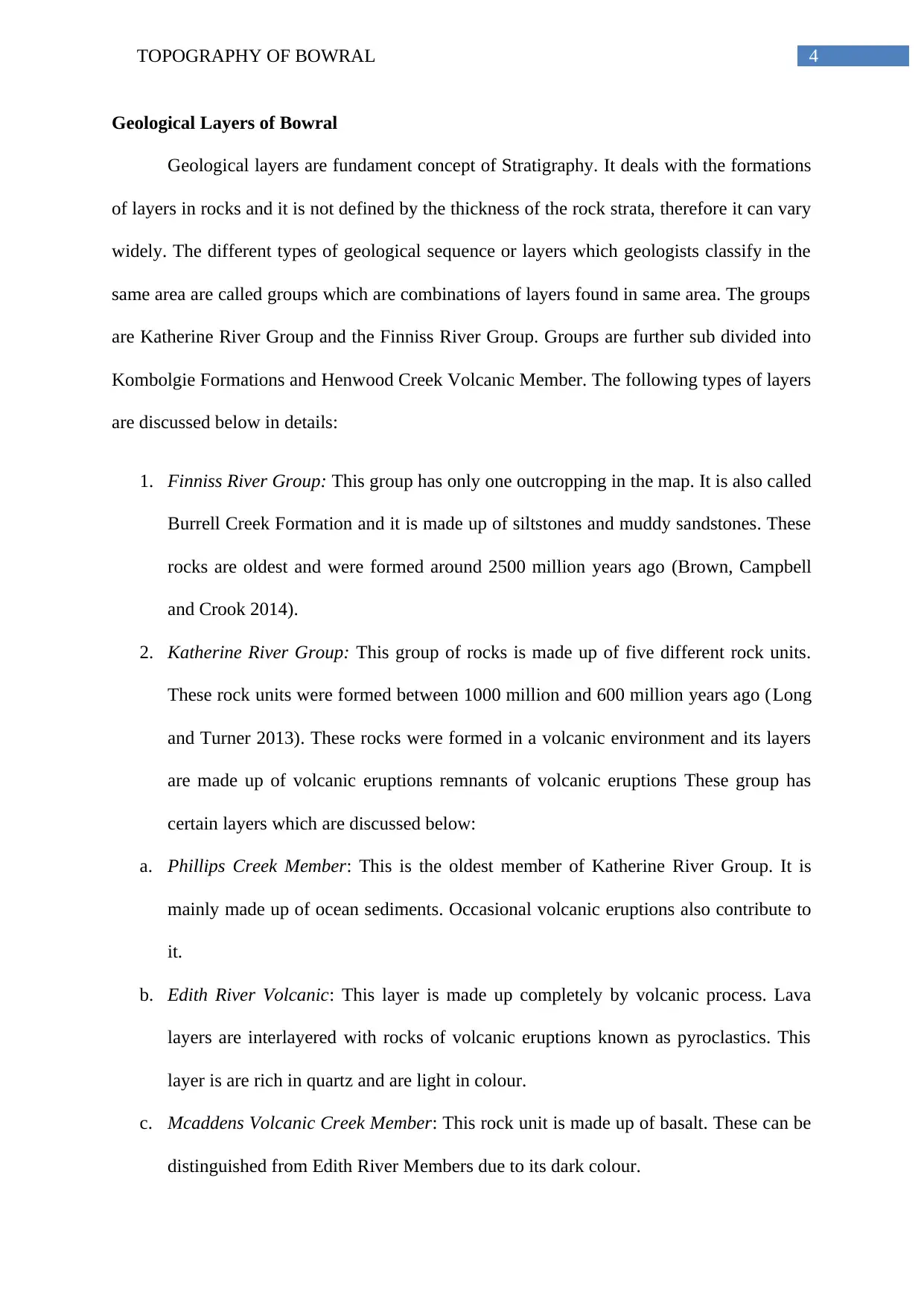
4TOPOGRAPHY OF BOWRAL
Geological Layers of Bowral
Geological layers are fundament concept of Stratigraphy. It deals with the formations
of layers in rocks and it is not defined by the thickness of the rock strata, therefore it can vary
widely. The different types of geological sequence or layers which geologists classify in the
same area are called groups which are combinations of layers found in same area. The groups
are Katherine River Group and the Finniss River Group. Groups are further sub divided into
Kombolgie Formations and Henwood Creek Volcanic Member. The following types of layers
are discussed below in details:
1. Finniss River Group: This group has only one outcropping in the map. It is also called
Burrell Creek Formation and it is made up of siltstones and muddy sandstones. These
rocks are oldest and were formed around 2500 million years ago (Brown, Campbell
and Crook 2014).
2. Katherine River Group: This group of rocks is made up of five different rock units.
These rock units were formed between 1000 million and 600 million years ago (Long
and Turner 2013). These rocks were formed in a volcanic environment and its layers
are made up of volcanic eruptions remnants of volcanic eruptions These group has
certain layers which are discussed below:
a. Phillips Creek Member: This is the oldest member of Katherine River Group. It is
mainly made up of ocean sediments. Occasional volcanic eruptions also contribute to
it.
b. Edith River Volcanic: This layer is made up completely by volcanic process. Lava
layers are interlayered with rocks of volcanic eruptions known as pyroclastics. This
layer is are rich in quartz and are light in colour.
c. Mcaddens Volcanic Creek Member: This rock unit is made up of basalt. These can be
distinguished from Edith River Members due to its dark colour.
Geological Layers of Bowral
Geological layers are fundament concept of Stratigraphy. It deals with the formations
of layers in rocks and it is not defined by the thickness of the rock strata, therefore it can vary
widely. The different types of geological sequence or layers which geologists classify in the
same area are called groups which are combinations of layers found in same area. The groups
are Katherine River Group and the Finniss River Group. Groups are further sub divided into
Kombolgie Formations and Henwood Creek Volcanic Member. The following types of layers
are discussed below in details:
1. Finniss River Group: This group has only one outcropping in the map. It is also called
Burrell Creek Formation and it is made up of siltstones and muddy sandstones. These
rocks are oldest and were formed around 2500 million years ago (Brown, Campbell
and Crook 2014).
2. Katherine River Group: This group of rocks is made up of five different rock units.
These rock units were formed between 1000 million and 600 million years ago (Long
and Turner 2013). These rocks were formed in a volcanic environment and its layers
are made up of volcanic eruptions remnants of volcanic eruptions These group has
certain layers which are discussed below:
a. Phillips Creek Member: This is the oldest member of Katherine River Group. It is
mainly made up of ocean sediments. Occasional volcanic eruptions also contribute to
it.
b. Edith River Volcanic: This layer is made up completely by volcanic process. Lava
layers are interlayered with rocks of volcanic eruptions known as pyroclastics. This
layer is are rich in quartz and are light in colour.
c. Mcaddens Volcanic Creek Member: This rock unit is made up of basalt. These can be
distinguished from Edith River Members due to its dark colour.
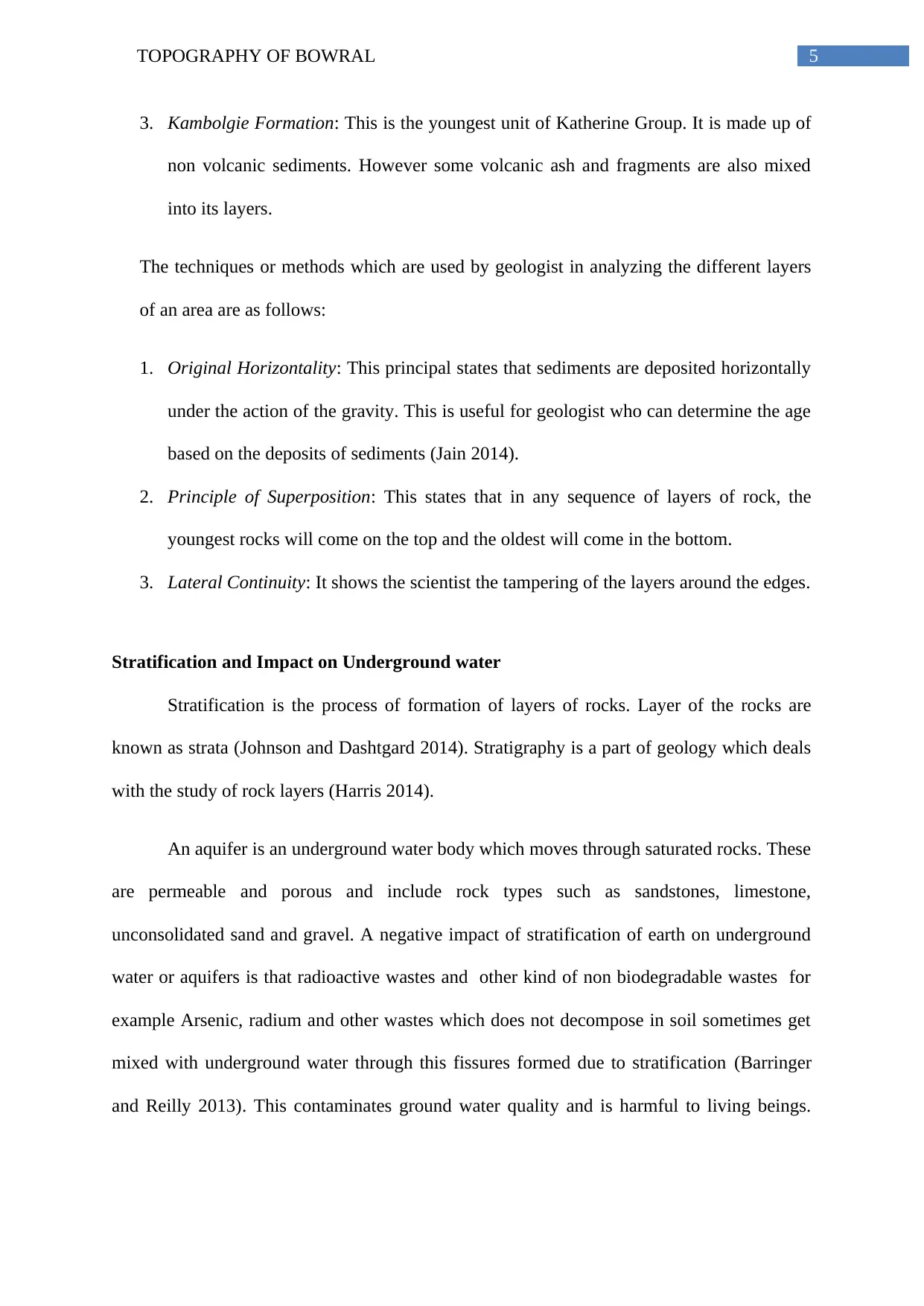
5TOPOGRAPHY OF BOWRAL
3. Kambolgie Formation: This is the youngest unit of Katherine Group. It is made up of
non volcanic sediments. However some volcanic ash and fragments are also mixed
into its layers.
The techniques or methods which are used by geologist in analyzing the different layers
of an area are as follows:
1. Original Horizontality: This principal states that sediments are deposited horizontally
under the action of the gravity. This is useful for geologist who can determine the age
based on the deposits of sediments (Jain 2014).
2. Principle of Superposition: This states that in any sequence of layers of rock, the
youngest rocks will come on the top and the oldest will come in the bottom.
3. Lateral Continuity: It shows the scientist the tampering of the layers around the edges.
Stratification and Impact on Underground water
Stratification is the process of formation of layers of rocks. Layer of the rocks are
known as strata (Johnson and Dashtgard 2014). Stratigraphy is a part of geology which deals
with the study of rock layers (Harris 2014).
An aquifer is an underground water body which moves through saturated rocks. These
are permeable and porous and include rock types such as sandstones, limestone,
unconsolidated sand and gravel. A negative impact of stratification of earth on underground
water or aquifers is that radioactive wastes and other kind of non biodegradable wastes for
example Arsenic, radium and other wastes which does not decompose in soil sometimes get
mixed with underground water through this fissures formed due to stratification (Barringer
and Reilly 2013). This contaminates ground water quality and is harmful to living beings.
3. Kambolgie Formation: This is the youngest unit of Katherine Group. It is made up of
non volcanic sediments. However some volcanic ash and fragments are also mixed
into its layers.
The techniques or methods which are used by geologist in analyzing the different layers
of an area are as follows:
1. Original Horizontality: This principal states that sediments are deposited horizontally
under the action of the gravity. This is useful for geologist who can determine the age
based on the deposits of sediments (Jain 2014).
2. Principle of Superposition: This states that in any sequence of layers of rock, the
youngest rocks will come on the top and the oldest will come in the bottom.
3. Lateral Continuity: It shows the scientist the tampering of the layers around the edges.
Stratification and Impact on Underground water
Stratification is the process of formation of layers of rocks. Layer of the rocks are
known as strata (Johnson and Dashtgard 2014). Stratigraphy is a part of geology which deals
with the study of rock layers (Harris 2014).
An aquifer is an underground water body which moves through saturated rocks. These
are permeable and porous and include rock types such as sandstones, limestone,
unconsolidated sand and gravel. A negative impact of stratification of earth on underground
water or aquifers is that radioactive wastes and other kind of non biodegradable wastes for
example Arsenic, radium and other wastes which does not decompose in soil sometimes get
mixed with underground water through this fissures formed due to stratification (Barringer
and Reilly 2013). This contaminates ground water quality and is harmful to living beings.
⊘ This is a preview!⊘
Do you want full access?
Subscribe today to unlock all pages.

Trusted by 1+ million students worldwide

6TOPOGRAPHY OF BOWRAL
Another impact is that ground water may not be extractable due to layers formations which
cannot be penetrated.
Figure 2: A picture showing Stratification of Rocks in Bowral region
Source: (Bulmer 2016).
Conclusion
The above report shows the analysis of stratification of Bowral region in Australia.
The report also shows the impacts of stratifications on Aquifers and natural underground
water sources. The report concludes with the negative impacts of stratification on human
beings and overall living beings. The report also shows how dumping of hazardous and
radioactive waste in soil impacts the water of aquifers and the overall impact on all living
beings.
Another impact is that ground water may not be extractable due to layers formations which
cannot be penetrated.
Figure 2: A picture showing Stratification of Rocks in Bowral region
Source: (Bulmer 2016).
Conclusion
The above report shows the analysis of stratification of Bowral region in Australia.
The report also shows the impacts of stratifications on Aquifers and natural underground
water sources. The report concludes with the negative impacts of stratification on human
beings and overall living beings. The report also shows how dumping of hazardous and
radioactive waste in soil impacts the water of aquifers and the overall impact on all living
beings.
Paraphrase This Document
Need a fresh take? Get an instant paraphrase of this document with our AI Paraphraser
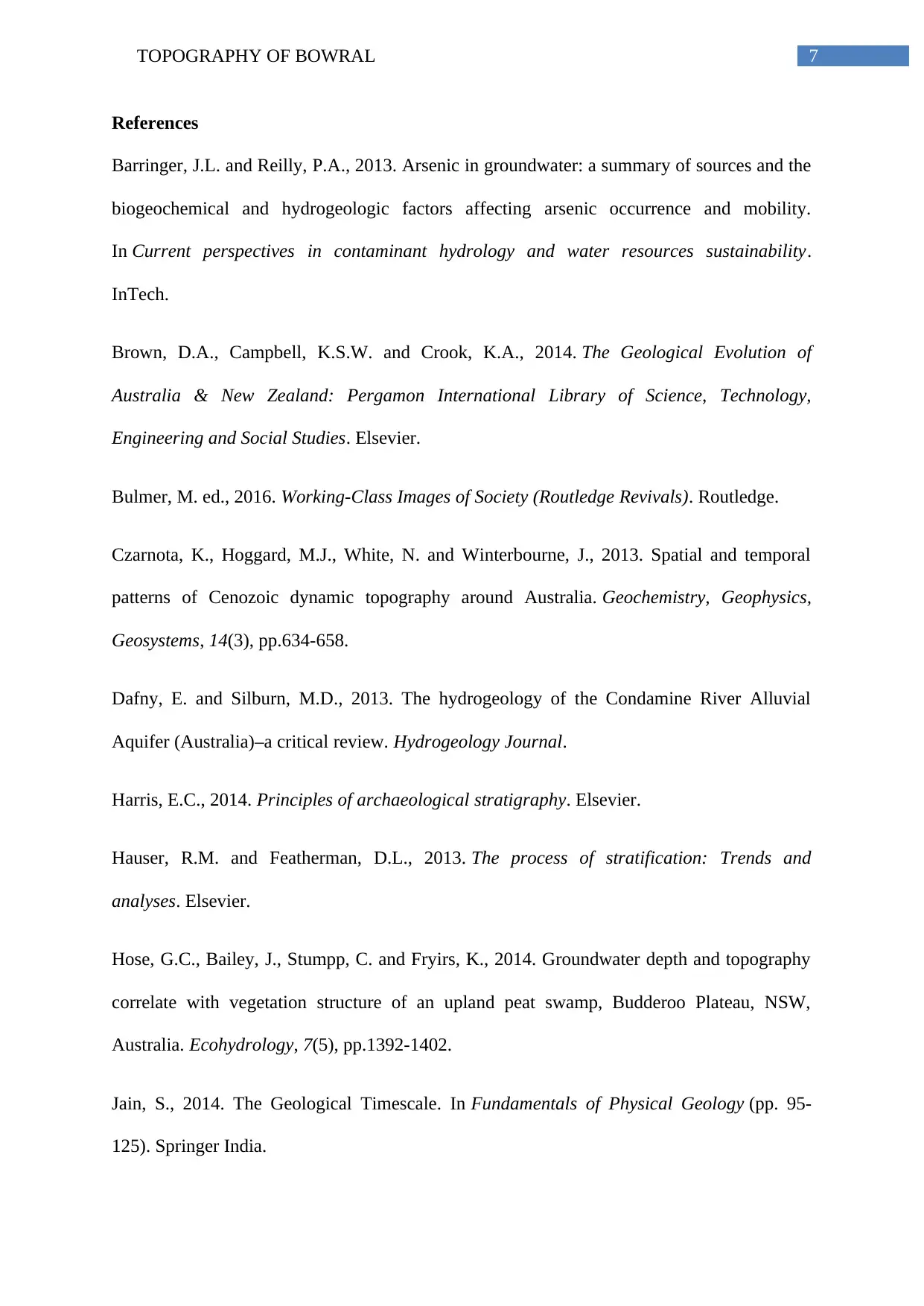
7TOPOGRAPHY OF BOWRAL
References
Barringer, J.L. and Reilly, P.A., 2013. Arsenic in groundwater: a summary of sources and the
biogeochemical and hydrogeologic factors affecting arsenic occurrence and mobility.
In Current perspectives in contaminant hydrology and water resources sustainability.
InTech.
Brown, D.A., Campbell, K.S.W. and Crook, K.A., 2014. The Geological Evolution of
Australia & New Zealand: Pergamon International Library of Science, Technology,
Engineering and Social Studies. Elsevier.
Bulmer, M. ed., 2016. Working-Class Images of Society (Routledge Revivals). Routledge.
Czarnota, K., Hoggard, M.J., White, N. and Winterbourne, J., 2013. Spatial and temporal
patterns of Cenozoic dynamic topography around Australia. Geochemistry, Geophysics,
Geosystems, 14(3), pp.634-658.
Dafny, E. and Silburn, M.D., 2013. The hydrogeology of the Condamine River Alluvial
Aquifer (Australia)–a critical review. Hydrogeology Journal.
Harris, E.C., 2014. Principles of archaeological stratigraphy. Elsevier.
Hauser, R.M. and Featherman, D.L., 2013. The process of stratification: Trends and
analyses. Elsevier.
Hose, G.C., Bailey, J., Stumpp, C. and Fryirs, K., 2014. Groundwater depth and topography
correlate with vegetation structure of an upland peat swamp, Budderoo Plateau, NSW,
Australia. Ecohydrology, 7(5), pp.1392-1402.
Jain, S., 2014. The Geological Timescale. In Fundamentals of Physical Geology (pp. 95-
125). Springer India.
References
Barringer, J.L. and Reilly, P.A., 2013. Arsenic in groundwater: a summary of sources and the
biogeochemical and hydrogeologic factors affecting arsenic occurrence and mobility.
In Current perspectives in contaminant hydrology and water resources sustainability.
InTech.
Brown, D.A., Campbell, K.S.W. and Crook, K.A., 2014. The Geological Evolution of
Australia & New Zealand: Pergamon International Library of Science, Technology,
Engineering and Social Studies. Elsevier.
Bulmer, M. ed., 2016. Working-Class Images of Society (Routledge Revivals). Routledge.
Czarnota, K., Hoggard, M.J., White, N. and Winterbourne, J., 2013. Spatial and temporal
patterns of Cenozoic dynamic topography around Australia. Geochemistry, Geophysics,
Geosystems, 14(3), pp.634-658.
Dafny, E. and Silburn, M.D., 2013. The hydrogeology of the Condamine River Alluvial
Aquifer (Australia)–a critical review. Hydrogeology Journal.
Harris, E.C., 2014. Principles of archaeological stratigraphy. Elsevier.
Hauser, R.M. and Featherman, D.L., 2013. The process of stratification: Trends and
analyses. Elsevier.
Hose, G.C., Bailey, J., Stumpp, C. and Fryirs, K., 2014. Groundwater depth and topography
correlate with vegetation structure of an upland peat swamp, Budderoo Plateau, NSW,
Australia. Ecohydrology, 7(5), pp.1392-1402.
Jain, S., 2014. The Geological Timescale. In Fundamentals of Physical Geology (pp. 95-
125). Springer India.
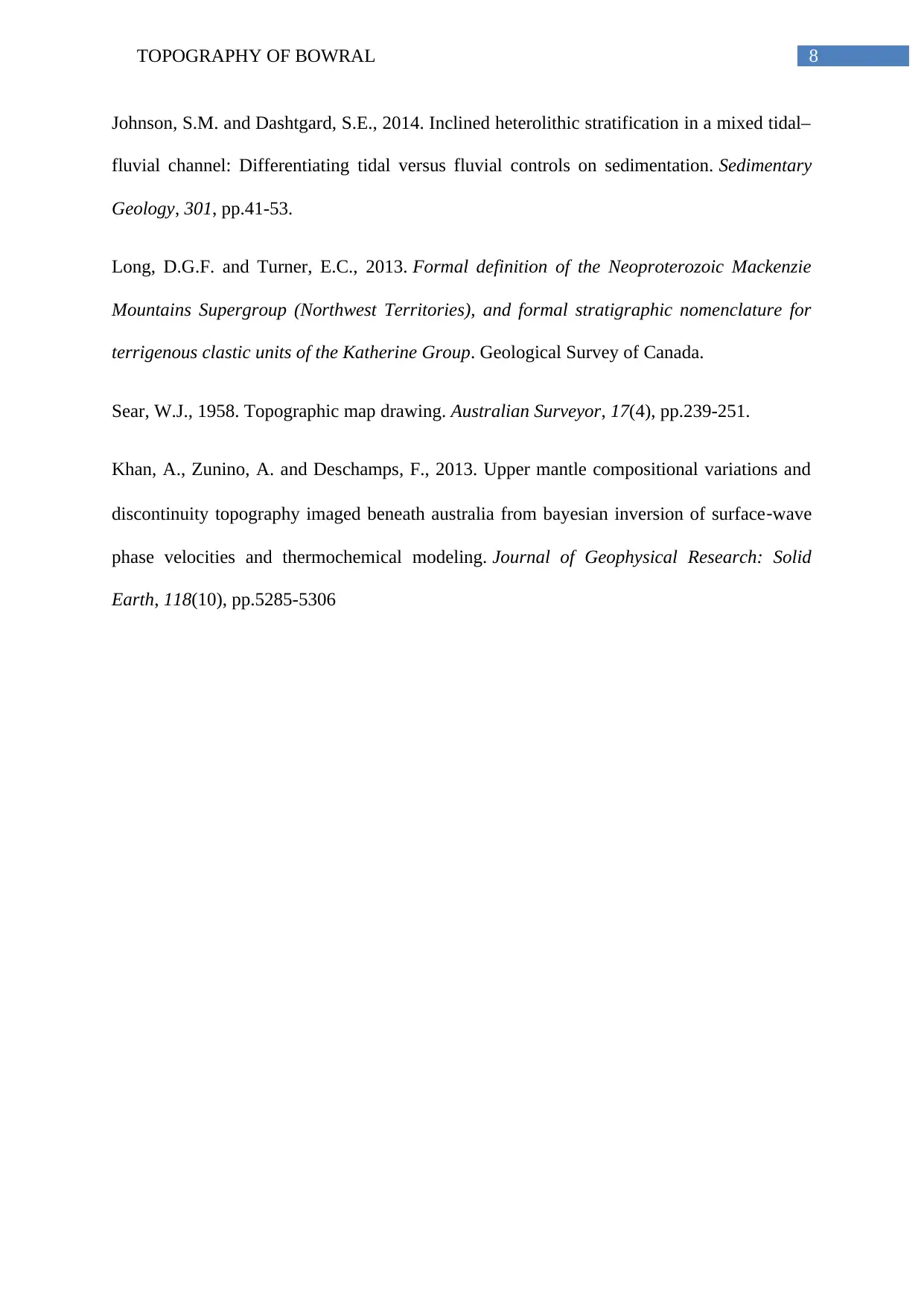
8TOPOGRAPHY OF BOWRAL
Johnson, S.M. and Dashtgard, S.E., 2014. Inclined heterolithic stratification in a mixed tidal–
fluvial channel: Differentiating tidal versus fluvial controls on sedimentation. Sedimentary
Geology, 301, pp.41-53.
Long, D.G.F. and Turner, E.C., 2013. Formal definition of the Neoproterozoic Mackenzie
Mountains Supergroup (Northwest Territories), and formal stratigraphic nomenclature for
terrigenous clastic units of the Katherine Group. Geological Survey of Canada.
Sear, W.J., 1958. Topographic map drawing. Australian Surveyor, 17(4), pp.239-251.
Khan, A., Zunino, A. and Deschamps, F., 2013. Upper mantle compositional variations and
discontinuity topography imaged beneath australia from bayesian inversion of surface‐wave
phase velocities and thermochemical modeling. Journal of Geophysical Research: Solid
Earth, 118(10), pp.5285-5306
Johnson, S.M. and Dashtgard, S.E., 2014. Inclined heterolithic stratification in a mixed tidal–
fluvial channel: Differentiating tidal versus fluvial controls on sedimentation. Sedimentary
Geology, 301, pp.41-53.
Long, D.G.F. and Turner, E.C., 2013. Formal definition of the Neoproterozoic Mackenzie
Mountains Supergroup (Northwest Territories), and formal stratigraphic nomenclature for
terrigenous clastic units of the Katherine Group. Geological Survey of Canada.
Sear, W.J., 1958. Topographic map drawing. Australian Surveyor, 17(4), pp.239-251.
Khan, A., Zunino, A. and Deschamps, F., 2013. Upper mantle compositional variations and
discontinuity topography imaged beneath australia from bayesian inversion of surface‐wave
phase velocities and thermochemical modeling. Journal of Geophysical Research: Solid
Earth, 118(10), pp.5285-5306
⊘ This is a preview!⊘
Do you want full access?
Subscribe today to unlock all pages.

Trusted by 1+ million students worldwide
1 out of 9
Your All-in-One AI-Powered Toolkit for Academic Success.
+13062052269
info@desklib.com
Available 24*7 on WhatsApp / Email
![[object Object]](/_next/static/media/star-bottom.7253800d.svg)
Unlock your academic potential
Copyright © 2020–2025 A2Z Services. All Rights Reserved. Developed and managed by ZUCOL.